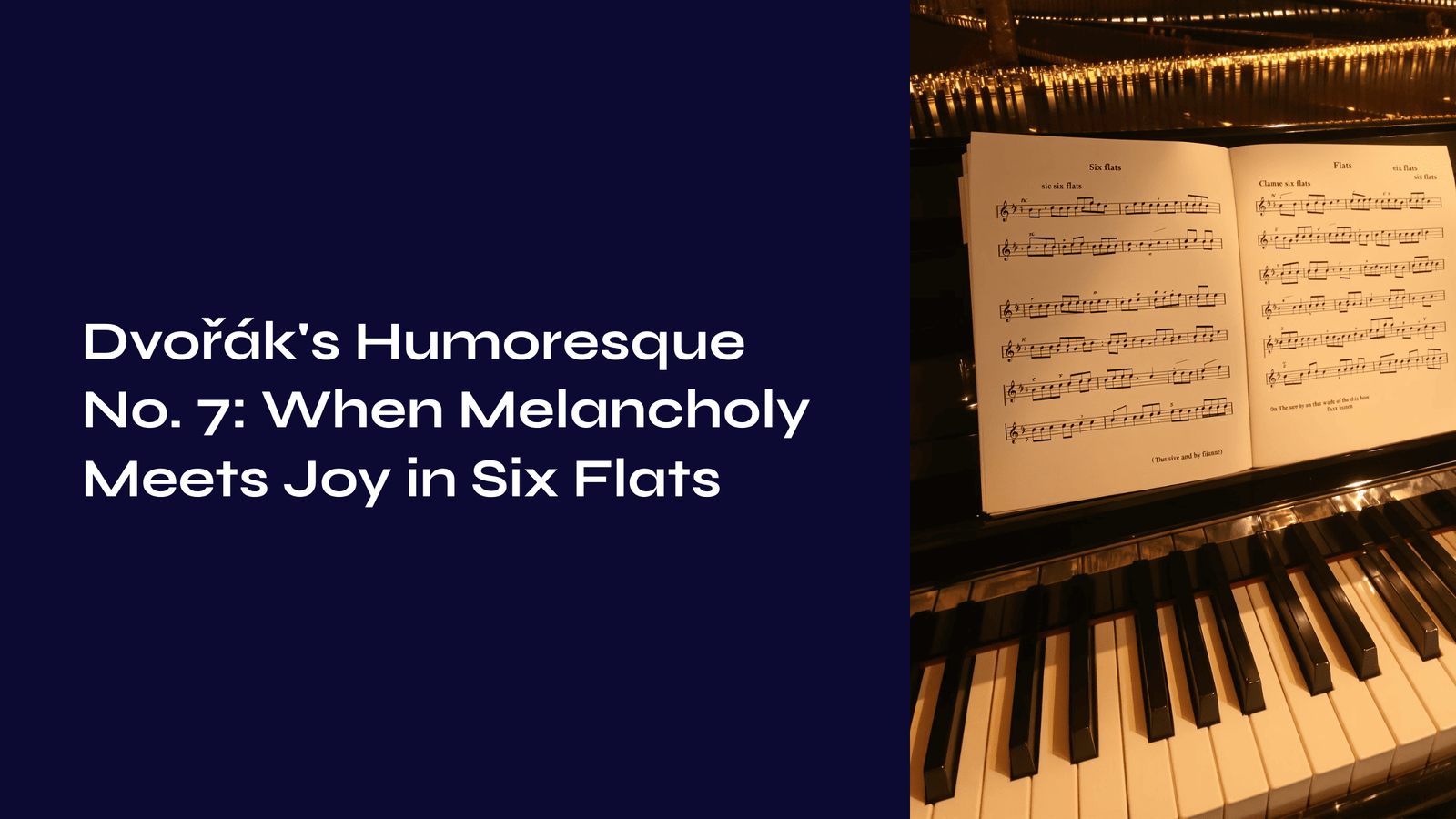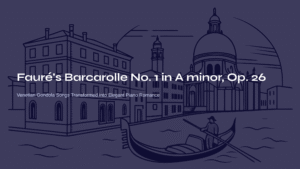Table of Contents

When Music Becomes Memory
There’s something almost magical about how certain melodies can transport us instantly to another place, another time. One such melody has been weaving its way through concert halls, living rooms, and even movie soundtracks for over a century now. It’s a tune that seems to carry both joy and wistfulness in equal measure, dancing gracefully through six flats as if the complexity of its key signature only adds to its charm.
This is the story of Dvořák’s Humoresque No. 7 in G-flat major – a piece that began life as a simple piano sketch and grew into one of classical music’s most beloved melodies.

A Composer Between Two Worlds
Antonín Dvořák’s Humoresque No. 7 emerged from one of the most creatively fertile periods in the composer’s life. During the summer of 1894, Dvořák was processing his experiences from his transformative American years, when he served as director of the National Conservatory of Music in New York from 1892 to 1895.
The piece represents a beautiful synthesis of musical worlds. While living in America, Dvořák had filled his sketchbooks with thematic ideas inspired by the melodies and rhythms he encountered there. Yet when he returned to his native Bohemia for the summer of 1894, these American influences began merging with his deep Czech musical heritage. The result was a collection of eight Humoresques, with the seventh becoming the crown jewel of the set.
The composition timeline was remarkably swift – Dvořák sketched the first Humoresque on July 19, 1894, and completed the entire cycle by August 27. This rapid creation suggests the music was flowing from a place of deep inspiration, as if the melodies had been waiting patiently in his notebooks for their moment to emerge.

The Gentle Paradox of a “Humoresque”
The title “Humoresque” often puzzles first-time listeners. Don’t expect comedy or obvious wit – the term represents something more subtle. In musical terms, a humoresque suggests whimsy and fancy rather than humor in the laugh-out-loud sense. It’s music that smiles rather than chuckles, expressing what one might call “fanciful humor in the sense of mood rather than wit.”
Dvořák’s choice of G-flat major adds another layer of intrigue. With its six flats, this key presents considerable technical challenges for performers. As one commentator wryly noted, “For the self-confident café piano player, Humoresque No. 7 is a punishment from God, respectively a punishment from Dvořák.” This challenging key signature likely served as a quality filter, ensuring that only serious musicians would tackle the piece and do justice to its subtle beauty.
The music itself unfolds in a classic ternary (ABA) form, but Dvořák’s genius lies in how seamlessly he weaves contrasting sections together. The melody opens with characteristic pentatonic touches that hint at both American influences and Czech folk traditions. It’s a tune that seems to reach upward with gentle, two-note steps, exploring various motivic possibilities before settling into moments of peaceful repose.

From Piano to Violin: A Beautiful Transformation
One of the most fascinating chapters in this piece’s history involves its metamorphosis from piano miniature to violin showpiece. Originally composed with a moderately paced metronome marking, the Humoresque underwent a dramatic character transformation when violinists discovered its potential.
Professional string players realized that while the melody was lovely at its original tempo, it became absolutely magical when played much slower. Many violinists began performing it as “a dreamy adagio,” effectively transforming what Dvořák wrote as “two in a bar” into “four in a bar.” This represents one of the rare instances in classical music where performers have successfully reinterpreted a composer’s intentions so completely that the new version became equally, if not more, beloved than the original.
Today, you’re as likely to hear this piece as a lyrical violin solo as you are to encounter it in its original piano form. Each medium brings out different qualities – the piano version highlighting the harmonic sophistication and rhythmic playfulness, while violin arrangements emphasize the melody’s soaring, vocal qualities.

A Personal Journey Through Six Flats
There’s something deeply moving about experiencing this piece unfold, regardless of the instrument. The opening melody seems to carry multiple emotions simultaneously – there’s joy, certainly, but also a thread of nostalgic longing that gives the music its particular poignancy. You can hear both the composer’s excitement about new musical discoveries and his homesickness for familiar Czech landscapes.
The middle section provides beautiful contrast, shifting the harmonic landscape while maintaining the piece’s essential character. It’s like watching the same beautiful vista from different angles – each view reveals new details while preserving the overall sense of wonder.
What strikes me most about this music is how it manages to be both sophisticated and immediately accessible. The technical demands are real – those six flats don’t lie – yet the emotional message comes through crystal clear to any listener. It’s music that rewards both casual enjoyment and deep analysis.

Discovering the Hidden Depths
When listening to Humoresque No. 7, try focusing on different elements across multiple hearings. First, simply let the melody wash over you – notice how it seems to breathe naturally, with phrases that feel like gentle conversations. Then listen for the harmonic progressions underneath, appreciating how Dvořák uses unexpected chord changes to add emotional color.
Pay attention to the piece’s dynamic range and phrasing. The best performances reveal a wide palette of expression within what might initially seem like a simple tune. Notice how the music’s character can shift dramatically based on tempo choices – the same notes can feel playful at a moderate pace or deeply contemplative when taken slowly.

If you’re hearing a violin performance, observe how the string techniques enhance the melody’s vocal qualities. The instrument’s ability to sustain and shape notes adds a singing quality that’s different from, but equally compelling as, the piano’s more percussive attack.
The Melody That Conquered the World
Nearly 130 years after its composition, Dvořák’s Humoresque No. 7 continues to captivate audiences worldwide. It has appeared in countless arrangements, from jazz interpretations by Art Tatum to film soundtracks that use its innocent beauty to create complex emotional effects. The piece has even acquired charming folklore, including the persistent legend that its rhythmic patterns at the end represent the sound of a train on tracks – a romantic notion that, while unsubstantiated by Dvořák himself, speaks to the music’s evocative power.
This little piece reminds us that in music, as in life, the most profound expressions often come in the most compact packages. Dvořák managed to distill a remarkable range of human emotion into just a few minutes of music, creating something that bridges the gap between artistic sophistication and popular appeal. It’s a melody that has found its way into hearts across cultures and generations, proving that truly great music speaks a universal language.
The Humoresque No. 7 stands as a testament to the power of melody to move us, to transport us, and to connect us across time and space. In our current world of constant noise and distraction, perhaps we need this kind of gentle, contemplative beauty more than ever.

If You Loved This, Listen to This Next
If you were moved by Dvořák’s ability to weave profound emotion into a deceptively simple melody in this Humoresque, you might find yourself equally captivated by Finding Solace in Bach’s Cello Suite No. 1: A Journey Through Musical Perfection – where similar intimacy and emotional depth create a meditative musical experience that speaks directly to the soul. Both works demonstrate how master composers can transform technical brilliance into deeply personal expressions that continue to offer comfort and inspiration across the centuries.



